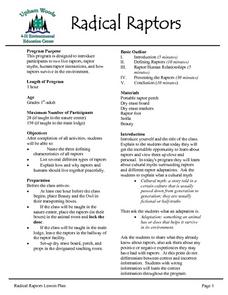Curated OER
Drosophila Melanogaster
Students cross wild type flies and mutants, both purchased from a biological supply house (Carolina Biological Supply or Wards, for example) in groups from lesson plan one.
Curated OER
Drosophila Melanogaster
Student manipulate flies, examine their external anatomy, begin a fly journal and make cultures of wild type flies. Students cross wild type flies and mutants, both purchased from a biological supply house (Carolina Biological Supply...
Curated OER
The Effect of Citrus Oils on Fruit Flies
Learners answer the question, "How could citrus fruits be toxic to fruit flies when fruit flies live on fruit?" They conduct an investigation using four different citrus oils and fruit flies and analyze data collected.
Curated OER
Drosophila Melanogaster
Students manipulate flies, examine their external anatomy, begin a fly journal and make cultures of wild type flies.
Curated OER
Probability Exercise
Follow fruit fly genetics with this probability activity. Biology scholars analyze the alleles of Bugsy, Daisy, Dino, and Lulu, considering traits for antennae, wing type, and eye color. They solve Punnett squares to determine the...
Curated OER
Characterizing Drosophila Mutants
Learners investigate wild-type and several mutant varieties of Drosophila melanogaster, which are characterized and distinguished according to pteridine pigments. They discoverthat paper chromatography of the wild-type Drosophila results...
Curated OER
The Forest-Life in the Wild!
Students write a description of each animal using their completed outline and include a graphic of the animal for the program, or a hand drawing. Each student chooses and writes about 2 Rain Forest Animals.
Curated OER
Birds
Pupils arms are measured with a yardstick and a tape measures. They discuss the many different types of birds. Students are asked to name some birds. They are given the worksheet Horned Lark Display Sheet. Pupils are told that Horned...
Curated OER
Radical Raptors
Students are introduced to raptors and their role in the environment. They identify three characteristics of raptors and list several types of raptors found in nature. They discuss their positive and negative experiences with raptors and...
Utah LessonPlans
Seed Sort
Students form a variety of categories for seed mixes (wild bird seed or 15 bean soup) and create graphs to display their categories.
Curated OER
Drosophila Melanogaster
Students collect their own flies and construct crosses, then compare them to the data from lesson two.
Curated OER
Birds of Wisconsin
First graders explore the job done by ornithologists. They role play identifying the characteristics that make a bird a bird. They discuss what makes each bird species unique. Students are introduced to Wisconsin's most common and rare...
Curated OER
The Same But Different
Fourth graders observe different types of bats. They look for characteristics that appear to be fundamental for survival. Students observe population numbers in order to identify if adaptations aid in survival.
Curated OER
Species Charades
Learners identify endangered species. In this endangered species lesson, the teacher leads a discussion about endangered species, then the class plays a game of charades to pantomime animal behavior.
Curated OER
Species Charades
Young scholars are introduced to a unit on endangered species. They study the diversity of endangered animals through a game of charades. After the game, students will discuss the animals that were acted out and why some of them are...
















